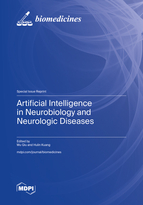Artificial Intelligence in Neurobiology and Neurologic Diseases
A special issue of Biomedicines (ISSN 2227-9059). This special issue belongs to the section "Neurobiology and Clinical Neuroscience".
Deadline for manuscript submissions: closed (31 January 2024) | Viewed by 38757
Special Issue Editors
Interests: stroke; brain ischemia; artificial intelligence; machine learning; deep learning
Special Issue Information
Dear Colleagues,
Millions of people are affected by neurological disorders. Patients with this condition have lots of limitations impacting not just their life but also their caregivers. Early detection of the condition can be improved with the help of Artificial Intelligence (AI) based techniques. AI is having a disruptive and transformative effect on clinical medicine. For neurology and neurobiology, there have been increasing interests in developing models and tools to address the complex patterns of connectivity in brain tissue. Cutting-edge AI-based approaches provide great opportunities for making new discoveries about the brain, improving current preventative and diagnostic models and developing more effective assistive neurotechnologies. This special issue focuses on current AI-driven approaches to clinical neuroscience and an assessment of the associated key methodological and ethical challenges. The fundamentals of AI in neurobiology and neurology, its applications and use cases in various areas of neurobiology and neurology and how AI-based algorithms can transform the management of neurological diseases will be favored. Research implications, novel methods involving deep learning models, AI-based neuroimaging using brain scans to detect neurological disease will be highlighted.
Dr. Wu Qiu
Dr. Hulin Kuang
Guest Editors
Manuscript Submission Information
Manuscripts should be submitted online at www.mdpi.com by registering and logging in to this website. Once you are registered, click here to go to the submission form. Manuscripts can be submitted until the deadline. All submissions that pass pre-check are peer-reviewed. Accepted papers will be published continuously in the journal (as soon as accepted) and will be listed together on the special issue website. Research articles, review articles as well as short communications are invited. For planned papers, a title and short abstract (about 100 words) can be sent to the Editorial Office for announcement on this website.
Submitted manuscripts should not have been published previously, nor be under consideration for publication elsewhere (except conference proceedings papers). All manuscripts are thoroughly refereed through a single-blind peer-review process. A guide for authors and other relevant information for submission of manuscripts is available on the Instructions for Authors page. Biomedicines is an international peer-reviewed open access monthly journal published by MDPI.
Please visit the Instructions for Authors page before submitting a manuscript. The Article Processing Charge (APC) for publication in this open access journal is 2600 CHF (Swiss Francs). Submitted papers should be well formatted and use good English. Authors may use MDPI's English editing service prior to publication or during author revisions.
Keywords
- artificial intelligence
- neurology
- neurobiology
- deep learning
- brain ischemia
Benefits of Publishing in a Special Issue
- Ease of navigation: Grouping papers by topic helps scholars navigate broad scope journals more efficiently.
- Greater discoverability: Special Issues support the reach and impact of scientific research. Articles in Special Issues are more discoverable and cited more frequently.
- Expansion of research network: Special Issues facilitate connections among authors, fostering scientific collaborations.
- External promotion: Articles in Special Issues are often promoted through the journal's social media, increasing their visibility.
- Reprint: MDPI Books provides the opportunity to republish successful Special Issues in book format, both online and in print.
Further information on MDPI's Special Issue policies can be found here.








